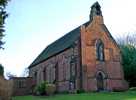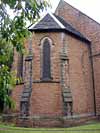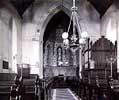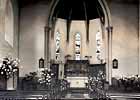For this church:    |
Kimberley Holy TrinityArchaeology
The church is of Early English design, constructed from Bulwell stone. The walls and four corners of the building are heavily buttressed, as is the apse which houses the sanctuary. At the west end there is a large gallery. On the south side of the apse is a small clergy vestry. The tiled roof of the nave is high pitched, and is supported by a double hammer beam ceiling. Originally there was a stone cross surmounting the eastern apex of the roof, whilst at the west end the small belfry remains from the original design.
The main arch leading from the choir to the sanctuary is supported by triform columns. The communion rails, now oak, were originally ironwork let into the stone floor. Major alterations to the church interior took place in 1937 to create a more austere building to be in keeping with the time. These changes included the addition of a choir vestry, new stalls, organ, and refurbishment of the sanctuary. The choir vestry, in brick, was built on the north side with a doorway being formed through the existing wall into the church. This necessitated the removal of the elevated pulpit and a replacement being constructed to the west of the new door. The alterations incorporated the new organ console being placed to the right of the choir vestry door. The pipes for the new organ were placed in the gallery, with its operating mechanism being located in the gallery access stairwell. This required the removal of the stair, and the gallery became unusable. Other changes included a new holy table, the moving forward of the sanctuary rails to enable the formation of a chancel. This movement enabled the installation of choir stalls, clergy desks as well accommodating the new pulpit and organ console. Redecoration also took place which included the painting over of the motto stencilled around the sanctuary arch 'Worship the Lord in the beauty of Holiness'.
The renovations also included the use of oak panelling to cover over the decorated stonework of the sanctuary altar screen. The stone screen comprises six arches, each division decorated with verses from the Bible. The cost of the alterations and refurbishments excluding organ costs totalled £885. This was raised by the individual giving of 447 people. Technical SummaryTimbers and roofs
BellframeSmall western bellcote Elphick type A, Pickford Group 9.A. 1847 Walls
Excavations and potential for survival of below-ground archaeologyThere have been no known archaeological excavations. The fabric of the building dates entirely from 1847 and was constructed on a new site. The previous use of the site is not known. The upstanding fabric is all 1847. The churchyard is rectangular with the church positioned centrally. Marked burials are present on the south side which date from a narrow period 1847-1883. No interments have taken place since 1883. The overall potential for the survival of below-ground archaeology in the churchyard, is considered to be UNKNOWN or LOW, comprising burials on the south side and evidence of building in the C19th; but possibly with evidence for the former use of the site which currently unknown. Below the present interior floors of the church it is considered to be LOW, comprising mid-C19th building evidence. The standing fabric of the church is all mid-C19th rebuilding and its potential as an example of the period is considered to be MODERATE. Exterior: Burial numbers expected to be low with burials probably only around the south side and dating from 1847-1883. Interior: Stratigraphy under the church is likely to be all mid-C19th building layers but with the possibility of pre-church use evident. |











